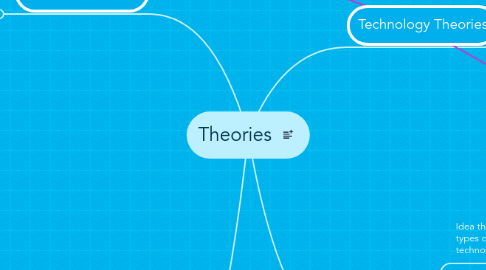
1. Learning Theories
1.1. Connectivism
1.1.1. Knowledge and learning is not concrete and can change.
1.1.2. Learning through connecting is more important than what we currently know.
1.1.3. Learning can be external to the individual and may be found in technology.
1.1.4. Connections are continual, ever-growing. Identifying connections between different ideas and concepts are very important skills.
1.2. Constructivism
1.2.1. Is student/learner centered.
1.2.2. Students create their own meanings through their experiences on the world around them.
1.2.3. Pre-existing views and knowledge is already brought into the classroom by the learner.
1.2.4. The teacher facilitates students to find their own knowledge rather than give them the knowledge beforehand.
1.3. Cognitive Load Theory
1.3.1. We have two kind of memories: long term and working. But, our working memory is limited.
1.3.2. When learning, the amount of information that must be processed at the same time can either over-load or under-load our working memory.
1.3.3. All students process at a different capacity but in order for meaningful learning to occur (what is learned is being stored in long term memory), the working memory must process at the right amount.
1.3.4. Cognitive Load Theory aims to minimize extraneous levels of cognitive load since it does not contribute to learning.
1.3.5. Teachers can encourage the right amount of cognitive load and promote meaningul meaning by changing their instructional design and how it is presented such as skills in organization, chunking, and presentation before presenting the learning material.
2. Philosophy of Teachnology
2.1. A new way of looking at teaching practices for teachers in relation to technology in the classroom.
2.2. The original form came from the philosophy of teaching in that teachers would develop a statement about their approach to teaching.
2.3. The philosophy of teachnology is a statement about a educator's personal view of using technology in their teaching.
2.4. Educators can include their own experiences with technology (such as personal learning networks) as well into their statement.
2.5. Educators can also address how might technology might benefit or how important it is in the classroom and outside it as well.
3. Technology Theories
3.1. Media Ecology
3.1.1. Study of technology as part of our cultural environment and how er communicate.
3.1.2. Media and technology affects us everyday.
3.1.3. Media effects our actions, perceptions, feelings, and how we experience the world around us.
3.2. SCOT (Social Construction of Technology)
3.2.1. A theory that argues that society shapes how we use and shape technology rather than technology's the one affecting us.
3.2.2. Sees technology as having potential to do good or bad.
3.2.3. Technology can be interpreted and used in various ways depending on who or what kind of group/organization is using it for.
3.2.4. This explains why some better technologies fail while others thrive because it is more socially popular.
